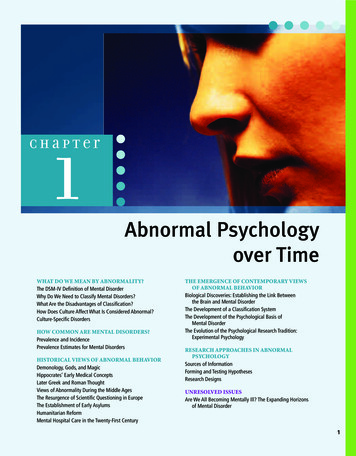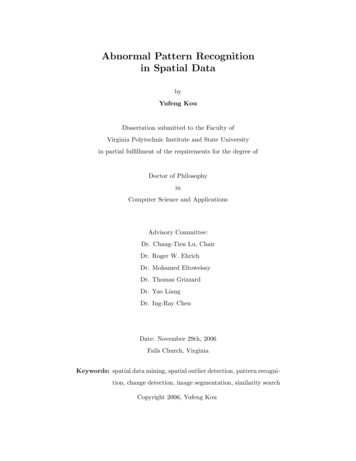
Transcription
9/2/2013Understanding AbnormalBehaviorChapter 1Historical Perspectives on Abnormal BehaviorWhere did it all begin? Abnormal behavior and psychological disordershave been documented for thousands of years. Although many early “treatments” are nowrecognized as cruel and ineffective, they wereconsidered state-of-the-art for their times. Treatments were influenced by the socialperception of mental illnessThe Scientific Approach Very early in history (500-700 A.D) theproblem was based on disorders may have natural causes and should be Scientists made very few significantadvances in the understanding ofabnormality until the eighteenthcentury.1
9/2/2013Spiritual Approach This approach regarded psychological disorders asthe Treatments included: Trephining Exorcism Treatments recommended by church“Treatments” became used to contain andcontrol the mentally ill. People with psychological disorders or "madmen" becameseen as dangerous animals who should be caged in order toprotect society. Since mental illness was not seen at this time as a medicalcondition,Humanitarian Approach The humanitarian approach developed throughout history, inpart as a reaction against the spiritual approach and itsassociated punishment of people with psychological disorders Mental hygiene movement Mental Retardation Facilities and Community Mental HealthCenter Construction Act2
9/2/2013These conditions contributed tothe ofthe mentally ill in America.The Mental Retardation Facilities and Community Mental Health CenterConstruction ActDid it work as promised? Deinstitutionalization has been criticized for failing to live upto its expectations. Although deinstitutionalization was designed to enhance thequality of life for people who had been held years in publicpsychiatric hospitals,The community mentalhealth movement has hadmany successes, butcontinues to remain3
9/2/2013AssessmentHow are psychologicaldisorders evaluated?Chapter 3 AssessmentWhat is Assessment? Assessment is a procedure in which a clinician Psychological assessment involves a broadrange of measurement techniques This evaluation occurs in a person whohave a psychological disorder.Clinical Assessment Only after a person is assessed can a diagnosis begiven. This is the process of determining whether apresenting problem meets the4
9/2/2013Why is it importantto have a process forassessing anddiagnosing people?Classification promotesUniversal standards Classification is the core of scientific study, which allowsresearchers to Classification facilitates research on etiology andtreatments of disorders, including best practices. To be diagnosed with a psychological disorder veryspecific criteria must be met.There is much debateon the classificationof mental disordersSome feel that diagnosis of psychological disorders do moreharm than good, fail to truly address the individual’s problemand create dehumanizing labels5
9/2/2013Types ofAssessmentClinical Interview Information is gathered by the professional bytalking with the client which provides informationabout:-- Symptoms- Unstructured Interview: A series of Structured Interview: andassessmentsClinical Description A presenting problem typicallyrefers to the specific problemthat brought the person in forhelp. 6
9/2/2013What’s the Presenting Problem?Patricia was referred to the crisis center forsuicidal thoughts and suicide attempt whichfollowed an argument with her boyfriend.Patricia ingested a bottle of prescriptionpain medication and drank small amountsof a household cleaning product. Patriciawas once hospitalized for major depressionand suicidal statements.What was thepresenting problem?Mental Status Exam Used by clinicians to determine whether or not apsychological disorder may be present. Most people do this everyday including you 7
9/2/2013What are some things youobserve when you meetsomeone for the first time?Mental status exams cover fivegeneral areas: Overt physical behaviors, appearance, body language,facial expression Are thoughts linear and organized? Are there delusions/hallucinations present?Mental Status(Mood and affect) Depressed," "anxious," "good," and "tired Does the person appear “down” orelated? Is it “appropriate”? You feel sad you looksad. 8
9/2/2013Mental StatusIntellectual functioning A variety of test are used to help determine levelof intellectual functioning: Repeat these 3 words: 'pen,' 'chair,' 'flag'The "serial 7s”Abstracts and metaphorsStandardized IQ tests (Standford-Binet, WAIS)Mental Status Sensorium refers to Clinicians assess a person’s orientation to time, placeand person. “Is the person oriented times 3?” DSM 5 ASSESSMENT MEASURES DSM-5’s Section 3 contains a set of assessment measures thatclinicians can use to enhance their decision-making process. These tools include a “cross-cutting” interview that reviews symptoms This review of symptoms would allow clinicians to drawattention to symptoms that may not fit precisely into the Such questions could be incorporated into a mental statusexamination.9
9/2/2013PsychologicalTestingWhat makes a psychologicaltest “good”? Validity: The consistency of a test, measurement, orcategory systemIf someone who is 200 poundssteps on a scale 10 times andgets readings of 150, 250, 95,140, etc., the scale is not reliable.If the scale consistently reads"150", then it is reliable, but notvalid.10
9/2/2013Standardized Tests There are literally hundreds of standardized tests clinicianscan use for assessment purposes.1.2.3.4.5.6.Intelligence TestingPersonality and Diagnostic TestingBehavioral AssessmentBiological TestsEnvironmental AssessmentMulticultural AssessmentPersonality and Diagnostic Testing Self –Report Clinical Inventories: These responses yield standardized measures ofpsychological symptoms and personality profiles Beck Depression Inventory-II (BDI-II) Minnesota Multiphasic Personality Inventory-2 (MMPI-2)11
9/2/2013Self-Report Inventories Advantages: Limitations: Neuropsychological Assessment Process of gathering information about the client’sbrain function based on their performance on tests. Neuropsychological tests are derived from or the same astests on the WAIS-IV. Tests that are used to identify markers ofpsychological disorders few are currently useful inassessing mental disorders Brain imaging and scanning: Electroencephalogram (EEG)Computerized axial tomography (CAT)Positron Emission Tomography (PET)Functional MRI (FMRI)12
Understanding Abnormal Behavior Chapter 1 Historical Perspectives on Abnormal Behavior Where did it all begin? Abnormal behavior and psychological disorders have been documented for thousands of years. Although many early “treatments” are now recognized as cruel and ineffectiv
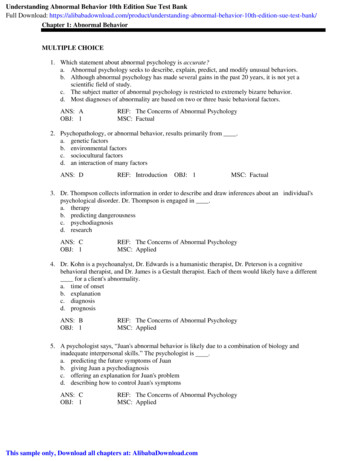
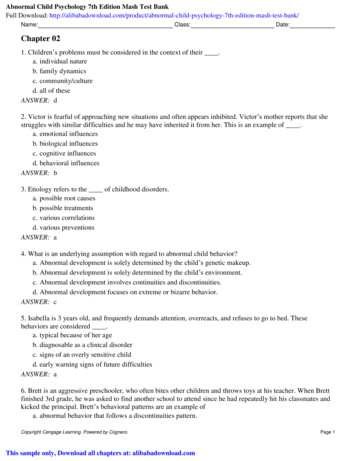
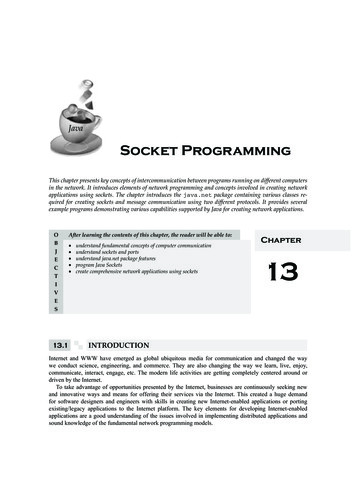
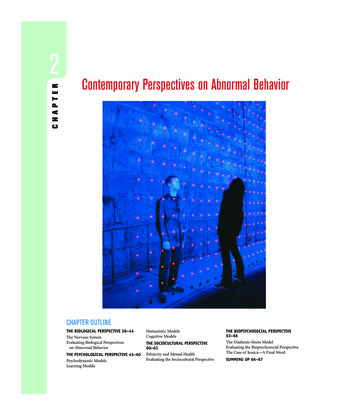
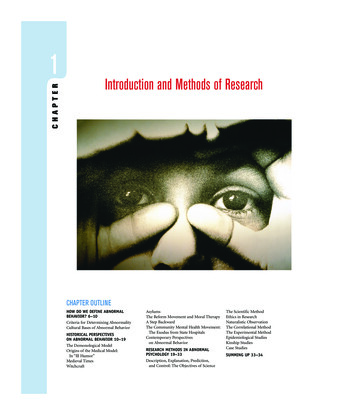
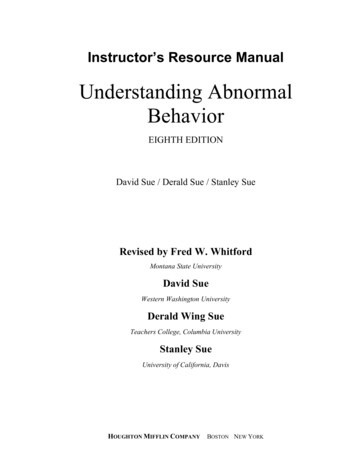
![[Unlocked] Chapter 16: Psychological Disorders](/img/28/chap16-20psy.jpg)
